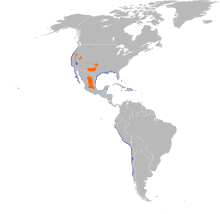
Back زقزاق ثلجي Arabic زقزاق ثلجى ARZ Corriol nevat Catalan Charadrius nivosus CEB Cwtiad gwyn Welsh Charadrius nivosus Spanish Charadrius nivosus Basque سلیم برفی Persian Pluvier neigeux French Charadrius nivosus Hungarian
| Snowy plover | |
|---|---|

| |
| Male in breeding plumage on Morro Strand State Beach, California | |
| Scientific classification | |
| Domain: | Eukaryota |
| Kingdom: | Animalia |
| Phylum: | Chordata |
| Class: | Aves |
| Order: | Charadriiformes |
| Family: | Charadriidae |
| Genus: | Anarhynchus |
| Species: | A. nivosus
|
| Binomial name | |
| Anarhynchus nivosus (Cassin, 1858)
| |

| |
Breeding range Resident range Non-breeding range
| |
The snowy plover (Anarhynchus nivosus) is a small shorebird found in the Americas. It is a member of the bird family Charadriidae, which includes the plovers, dotterels, and lapwings. The snowy plover was originally described by John Cassin in 1858, but was classified as a subspecies of the Kentish plover in 1922. Since 2011, the snowy plover has been recognized as a distinct species based on genetic and anatomical differences from the Kentish plover. Two or three subspecies are recognized, distributed along the Pacific coast of North America, Ecuador, Peru, and Chile, in several inland areas of the US and Mexico, along the Gulf Coast, and on Caribbean islands. The coastal populations consist of both residential and migratory birds, whereas the inland populations are mostly migratory. It is one of the best studied endemic shorebirds of the Americas, and one of the rarest.
Snowy plovers are pale brown above and white below, with a white band on the hind neck. During the breeding season, males have black patches behind the eye and on the side of the neck; the neck patches are separated from each other and do not form a continuous breast band as in many other plovers. Snowy plovers can also be distinguished from other plovers in having an all-black and slender bill, and gray to black legs. The typical call is a repeated "tu-wheet".
This plover inhabits open areas in which vegetation is absent or sparse, in particular coastal sand beaches and shores of salt or soda lakes, where it feeds on invertebrates such as crustaceans, worms, beetles, and flies. At the beginning of the breeding season, males excavate multiple nest scrapes that are advertised to females; one of these scrapes is later selected for breeding. Some females will desert their brood soon after the chicks hatch to re-mate with another male, while their first mate will continue to rear the chicks. Such polygamy is uncommon in birds, and is possibly a strategy to maximize breeding success. There are more males than females – 1.4 times as many in California – and the more pronounced this sex ratio imbalance is, the more females engage in polyandrous behavior.
The snowy plover is listed as near threatened by the International Union for Conservation of Nature. The main threats are habitat destruction due to invasive beach grasses, urban development, as well as frequent disturbance due to recreational uses of beaches. Conservation measures on the US Pacific coast include roping-off beach areas that are used for breeding, the removal of invasive beach grasses, and protection against egg predators. While such measures have been successful locally, the global population is thought to be in decline.
- ^ BirdLife International (2020). "Charadrius nivosus". IUCN Red List of Threatened Species. 2020: e.T22725033A181360276. doi:10.2305/IUCN.UK.2020-3.RLTS.T22725033A181360276.en. Retrieved 22 July 2023.
© MMXXIII Rich X Search. We shall prevail. All rights reserved. Rich X Search
